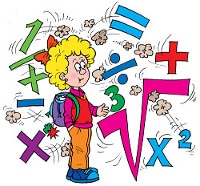Math is a challenging subject for many students, and while RTI was originally created to help with reading, it can (and should) be used across the curriculum. The following RTI approach can be used to help students solve mathematical equations.
Model and Solve Equations Using Manipulatives:
Using manipulatives is the only way some students can truly understand mathematical concepts. Unfortunately, a prevailing myth in secondary education, especially high schools, is that manipulatives are for elementary children only. I am a strong advocate for using manipulatives and concrete representation for teaching math to students at the secondary level, including high school students.
I was always saddened when a new math teacher attempted to use algebra tiles to teach algebraic concepts and then gave up the effort because of negative feedback from either the students or math colleagues. New research in the field promoting a three-pronged approach to teaching math at the secondary level is encouraging. The Concrete, Representation, Abstract (CRA) approach is a breakthrough in secondary thinking.
Research Background:
Using manipulatives provides students a meaningful context for mathematical knowledge and helps them understand fundamental relationships associated with the. Multiple embodiments – the use of many different models – allow students to focus on common characteristics and generalize to the abstract.
In regards to secondary math, such as Algebra, Henri Picciotto, a mathematics specialist and former teacher writes:
“Even though they cannot make Algebra easy, manipulatives can play an important role in the transition to a new algebra course:
• They provide access to symbol manipulation for students who had previously been frozen out of the course because of their weak number sense.
• They provide a geometric interpretation of symbol manipulation, thereby enriching all students’ understanding, and making a powerful connection to another part of mathematics.
• They support cooperative learning, and help improve discourse in the algebra class by giving students objects to think with and talk about. It is in the context of such reflection and conversation that learning happens.”
There are four main commercial versions of algebra manipulatives. In order of their appearance on the market, they are Algebra Tiles (Cuisenaire), the Lab Gear (Creative Publications), Algeblocks (Southwestern Publishing), and Algebra Models (Classroom Products). All four provide a worthwhile model of the distributive law. However, note that only the Lab Gear and Algeblocks allow work in three dimensions.
Bradley Witzel, co-author of the book Solving Equations – An Algebra Intervention, is also an advocate of using manipulatives to teach math through algebra. He describes the Concrete Representation Abstract method. The CRA sequence of instruction consists of teaching students to solve mathematics problems through three levels of instruction, from the manipulation of concrete objects to learning through pictorial representations to finally solving equations through abstract notation.
According to Witzel, the CRA approach to teaching mathematics has proven to be beneficial to secondary students with math difficulties, from small group settings to whole-class instruction. In fact, after receiving CRA instruction, students with learning disabilities had a success rate two to three times higher than their traditionally taught peers.
Witzel also states that CRA benefits students with math difficulties because it presents information in a multisensory way: visually, auditorily, tactilely, and kinesthetically. This multisensory approach causes the brain to process the information several times in various formats, making it easier for students to memorize, encode, and retrieve the information later.
In addition, CRA helps students solve abstract problems without thinking fluently at the abstract level by giving them other levels of learning, whether pictorial or concrete, to turn to solve the problem.
Try using the CRA approach in your classroom and watch your students, even those who struggle most with mathematics, begin to succeed. For more information on this subject and for practical ways to implement this strategy in your classroom, read my newest book, RTI for Secondary Teachers.

